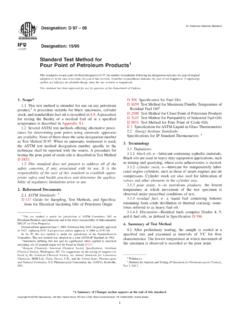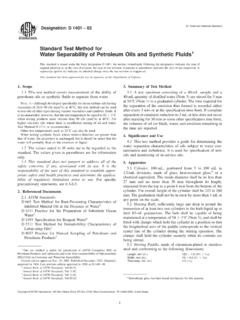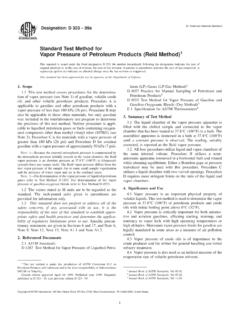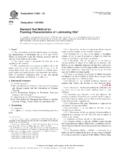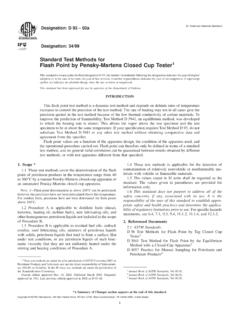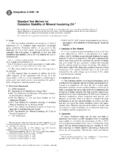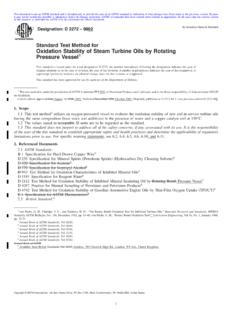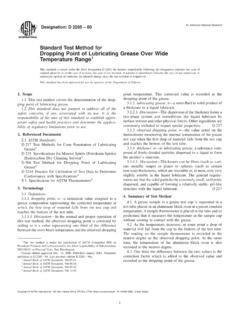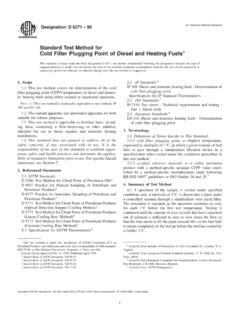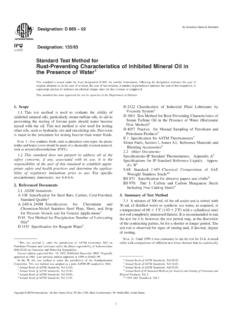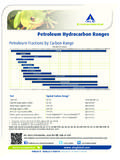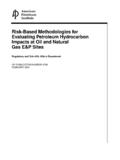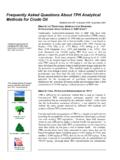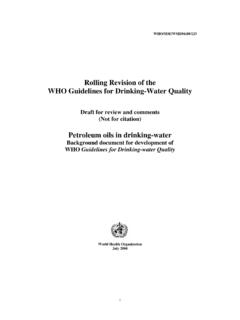Transcription of Standard Test Methods for Aniline Point and Mixed …
1 Designation: D 611 04 Designation: 2/98An American National StandardStandard Test Methods forAniline Point and Mixed Aniline Point of petroleum Productsand Hydrocarbon Solvents1 This Standard is issued under the fixed designation D 611; the number immediately following the designation indicates the year oforiginal adoption or, in the case of revision, the year of last revision. A number in parentheses indicates the year of last reapproval. Asuperscript epsilon (e) indicates an editorial change since the last revision or Standard has been approved for use by agencies of the Department of Scope* These test Methods cover the determination of theaniline Point of petroleum products and hydrocarbon Method A is suitable for transparent samples with aninitial boiling Point above room temperature and where theaniline Point is below the bubble Point and above the solidifi-cation Point of the Aniline -sample mixture.
2 Test Method B, athin-film method, is suitable for samples too dark for testing byTest Method A. Test Methods C and D are for samples that mayvaporize appreciably at the Aniline Point . Test Method D isparticularly suitable where only small quantities of sample areavailable. Test Method E describes a procedure using anautomatic apparatus suitable for the range covered by TestMethods A and These test Methods also cover the determination of themixed Aniline Point of petroleum products and hydrocarbonsolvents having Aniline points below the temperature at whichaniline will crystallize from the Aniline -sample Standard does not purport to address all of thesafety concerns, if any, associated with its use. It is theresponsibility of the user of this Standard to establish appro-priate safety and health practices and determine the applica-bility of regulatory limitations prior to warningstatements are given in Section Referenced Standards:2D 1500 Test Method for ASTM Color of petroleum Prod-ucts (ASTM Color Scale)E 1 Specification for ASTM Liquid-in-Glass Thermometers3.
3 Point the minimum equilibrium solutiontemperature for equal volumes of Aniline and Aniline Point the minimum equilibrium solu-tion temperature of a mixture of two volumes of Aniline , onevolume of sample, and one volume ofn-heptane of Summary of Test Specified volumes of Aniline and sample, or Aniline andsample plusn-heptane, are placed in a tube and mixedmechanically. The mixture is heated at a controlled rate untilthe two phases become miscible. The mixture is then cooled ata controlled rate and the temperature at which two phasesseparate is recorded as the Aniline Point or Mixed Aniline Significance and The Aniline Point (or Mixed Aniline Point ) is useful as anaid in the characterization of pure hydrocarbons and in theanalysis of hydrocarbon mixtures. Aromatic hydrocarbonsexhibit the lowest, and paraffins the highest values. Cyclopar-affins and olefins exhibit values that lie between those forparaffins and aromatics.
4 In homologous series the anilinepoints increase with increasing molecular weight. Although itoccasionally is used in combination with other physical prop-erties in correlative Methods for hydrocarbon analysis, theaniline Point is most often used to provide an estimate of thearomatic hydrocarbon content of test Methods are under the jurisdiction of ASTM Committee D02 onPetroleum Products and Lubricants and are the direct responsibility of onHydrocarbon edition approved May 1, 2004. Published June 2004. Originallyapproved in 1941. Last previous edition approved in 2001 as D 611 test Methods were adopted as a joint ASTM-IP Standard in referenced ASTM standards, visit the ASTM website, , orcontact ASTM Customer Service at ForAnnual Book of ASTMS tandardsvolume information, refer to the Standard s Document Summary page onthe ASTM *A Summary of Changes section appears at the end of this ASTM International, 100 Barr Harbor Drive, PO Box C700, West Conshohocken, PA 19428-2959, United For details of the Aniline Point apparatus required foreach method see.
5 Annex A1 for Test Method AAnnex A2 for Test Method BAnnex A3 for Test Method CAnnex A4 for Test Method DAnnex A5 for Test Method ENOTE1 Alternative apparatus may be used, such as the U-tubemethod for dark oils, provided it has been shown to give results of thesame precision and accuracy as those described in the and Cooling Bath A suitable air bath, anonvolatile, transparent liquid bath, or an infrared lamp (250 to375 W), provided with means for controlling the rate Water should not be used as either a heating or coolingmedium since Aniline is hygroscopic and moist Aniline will give erroneoustest results. For example, the Aniline Point of then-heptane reagent asmeasured with Aniline containing volume % water is C ( F) higher than that measured with dry Aniline . If the anilinepoint is below the dew Point of the atmosphere, pass a slow stream of dryinert gas into the Aniline Point tube to blanket the Aniline -sample , or other temperature sensing devices,such as thermocouples or platinum resistance thermometersthat cover the temperamental range of interest and can provideequivalent or better accuracy and precision, may be used inplace of the thermometers having the following ranges andconforming to the requirements of the designated ASTM or IPspecification.
6 RangeASTM(Specification E 1)IP 38 to + 42 C ( to + F)33C, 33F20C25 to 105 C (77 to 221 F)34C, 34F21C90 to 170 C (194 to 338 F)35C, , or equivalent volume dispensing devices, ca-pable of delivering volumes with capacities of mLand mL, for use in the A laboratory balance sensitive to g,suitable for weighing the tube and sample when the samplecannot be pipetted Gloves, impervious to (Warning Aniline should not be pipetted di-rectly by mouth because of its extreme toxicity. Aniline is alsotoxic by absorption through the skin even invery smallquantities,and should be handled with great caution.) Distillchemically pure Aniline and dry as needed to meet purityrequirements for use, discarding the first and last 10 %. Anilinethus prepared when tested withn-heptane according to Section9 shall give an Aniline Point of C ( F)as determined from the average of two independent testshaving a difference of not more than C ( F).
7 NOTE3 For routine purposes the distillation process is not mandatoryprovided the Aniline meets the requirements of the test As an alternative to distilling the Aniline on the day of use, theaniline may be distilled as described in , collecting the distillate inampoules, sealing the ampoules under vacuum or dry nitrogen, and storingin a cool dark place for future use. Alternatively, distillate may be storedunder dry nitrogen in a glass bottle or in single use ampules kept in a cool,dark place. In either case, rigid precaution must be taken to avoidcontamination from atmospheric moisture (Note 2). It is believed thatunder these conditions the Aniline will remain unchanged for a periodexceeding 6 Sulfate, , spectroscopic or HPLC grade. (Warning Flammable. Harmful if inhaled. Keep away from heat, sparks,and open flame. Keep container closed. Use with adequateventilation. Avoid prolonged breathing of vapor or spray prolonged or repeated skin contact.)
8 8. Dry the sample by shaking vigorously for 3 to 5 minwith about 10 volume % of a suitable drying agent such asanhydrous calcium sulfate or anhydrous sodium sulfate. Re-duce the viscosity of viscous samples by warming to atemperature below that which would cause the loss of lightends or the dehydration of the drying agent. Remove anysuspended drying agent by use of a centrifuge or by samples containing separated wax until they are homo-geneous and keep heated during filtration or centrifugation toensure against separation of wax. When suspended water isvisibly present and the sample material is known to dissolveless than mass % of water, the use of a centrifuge for theremoval of suspended water is an acceptable Procedure for Aniline The following Methods , to be used as applicable, arecovered as Method A, described in detail in Annex A1, isapplicable to clear samples or to samples not darker than ASTM color, as determined by Test Method D 1500,having initial boiling points well above the expected Method B, described in detail in Annex A2, isapplicable to light-colored samples, moderately dark samples,and to very dark samples.
9 It is suitable for samples that are toodark to be tested by Test Method Method C, described in detail in Annex A3, isapplicable to clear samples or to samples not darker than ASTM color, as determined by Test Method D 1500,having initial boiling points sufficiently low as to give incorrectaniline Point readings by Test Method A, for example, Method D, described in detail in Annex A4, isapplicable to the same type of sample as Test Method C. It isparticularly useful when only limited quantities of sample Method Eis applicable when using automaticapparatus in accordance with the instructions in Annex Procedure for Mixed Aniline This procedure is applicable to samples having anilinepoints below the temperature at which Aniline crystallizes fromthe mixture. Deliver 10 mL of Aniline (Warning See ), 5mL of sample, and 5 mL ofn-heptane into a clean, dryapparatus. Determine the Aniline Point of the mixture by TestMethod A or B as described in Annex A1 or Annex 04211.
10 If the range of three successive observations of theaniline Point temperature is not greater than C ( F) forlight-colored samples or C ( F) for dark samples, reportthe average temperature of these observations, corrected forthermometer calibration errors, to the nearest C ( F) asthe Aniline If such a range is not obtained after five observations,repeat the test using fresh quantities of Aniline and sample in aclean, dry apparatus, and if consecutive temperature observa-tions show a progressive change, or if the range of observationsis greater than the repeatability given in , report the testmethod as being Precision and The precision of these test Methods as obtained bystatistical examination of interlaboratory test results is The difference between successivetest results (two average temperatures obtained in a series ofobservations as described in Section 11 obtained by the sameoperator with the same apparatus under constant operatingconditions on identical test material, would in the long run, inthe normal and correct operation of the test method, exceed thefollowing values only in one case in twenty:RepeatabilityAniline Point of.)
